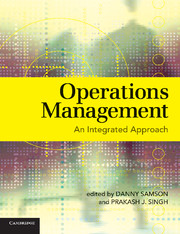Book contents
- Frontmatter
- Contents
- List of Contributors
- Preface
- Acknowledgements
- Part I Operations within Organisations – Building Blocks
- Part II Approaches to Understanding OM
- Part III Moving Forward with OM – Creating Competitive Advantage
- Part IV Challenges and Opportunities in Operations
- Part V Case Studies
- 1 Innovation in the Biotechnology Sector: The Case of IDT Australia
- 2 New Zealand King Salmon: Value-Chain Innovation
- 3 Pilila Clothing Company Goes Lean
- 4 From Singapore to the World: Port Management in Singapore
- 5 Striving for Operations Excellence within Queensland Rail Supply Division
- 6 Should I Stay or Should I Go? Shiraishi Garments Company
- 7 Towards a Green Supply Chain: Toyota Australia
- 8 Process Analyses and Improvement at Bartter Enterprises
- 9 Operations Challenges at Firth Industries Limited, Wellington Division
- 10 Ford Motor Company: Moving Forward in Australia
- 11 Technology Transfer at Hero Honda
- 12 Why Is the Patient Resident Time so Long?: The Case of St Martin's and Charity Private Hospital
- Index
2 - New Zealand King Salmon: Value-Chain Innovation
Published online by Cambridge University Press: 05 June 2012
- Frontmatter
- Contents
- List of Contributors
- Preface
- Acknowledgements
- Part I Operations within Organisations – Building Blocks
- Part II Approaches to Understanding OM
- Part III Moving Forward with OM – Creating Competitive Advantage
- Part IV Challenges and Opportunities in Operations
- Part V Case Studies
- 1 Innovation in the Biotechnology Sector: The Case of IDT Australia
- 2 New Zealand King Salmon: Value-Chain Innovation
- 3 Pilila Clothing Company Goes Lean
- 4 From Singapore to the World: Port Management in Singapore
- 5 Striving for Operations Excellence within Queensland Rail Supply Division
- 6 Should I Stay or Should I Go? Shiraishi Garments Company
- 7 Towards a Green Supply Chain: Toyota Australia
- 8 Process Analyses and Improvement at Bartter Enterprises
- 9 Operations Challenges at Firth Industries Limited, Wellington Division
- 10 Ford Motor Company: Moving Forward in Australia
- 11 Technology Transfer at Hero Honda
- 12 Why Is the Patient Resident Time so Long?: The Case of St Martin's and Charity Private Hospital
- Index
Summary
Introduction
Driving to work alongside the scenic and sprawling Tahunanui beach, Paul Steere, Chief Executive of New Zealand King Salmon (NZKS), had reason to smile at the holidaymakers who bathed in the glorious Nelson sun. A recent industry report had revealed NZKS to be in the top 1–2 per cent of salmon farming companies around the world in terms of profitability. It was a far cry from the trying times the company had gone through some years previously. Paul and others in the executive team had the firm conviction that the turnaround was due in no small measure to NZKS's concerted attempts to engage in R&D even in financially troubled periods.
In actual fact, Paul had convened a strategy meeting for that morning, following the three-day Waitangi weekend of 2004. The executive team of NZKS comprised, besides Paul, Don Everitt, GM (Sales & Marketing) who also oversaw new product development (NPD), Bryce Gilchrist, who was GM (Corporate Services & Finance), Paul McHugh, who was GM (Manufacturing), and Stewart Hawthorn, the GM (Aquaculture). The agenda was the budgeting and allocation of investment in R&D; a vertically integrated company such as NZKS naturally offered several avenues for such investment, thereby invariably calling for tradeoffs.
- Type
- Chapter
- Information
- Operations ManagementAn Integrated Approach, pp. 419 - 434Publisher: Cambridge University PressPrint publication year: 2008



